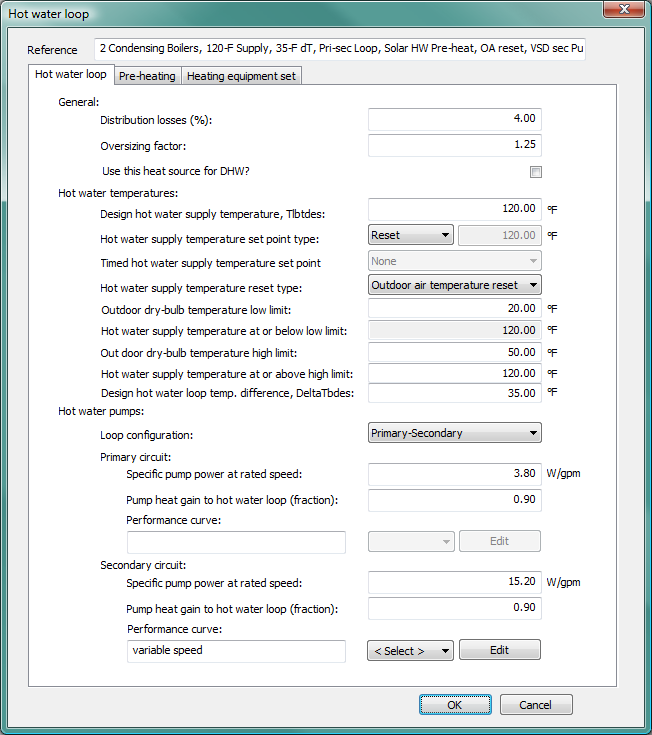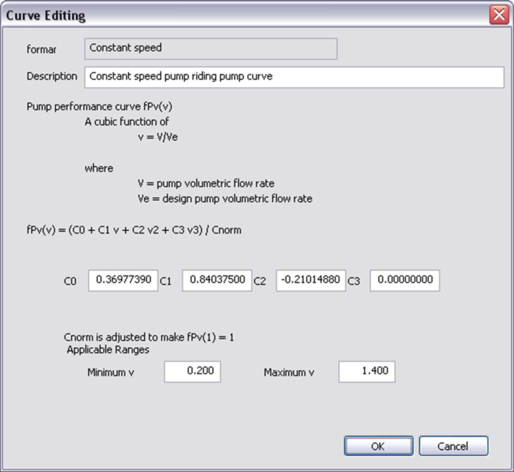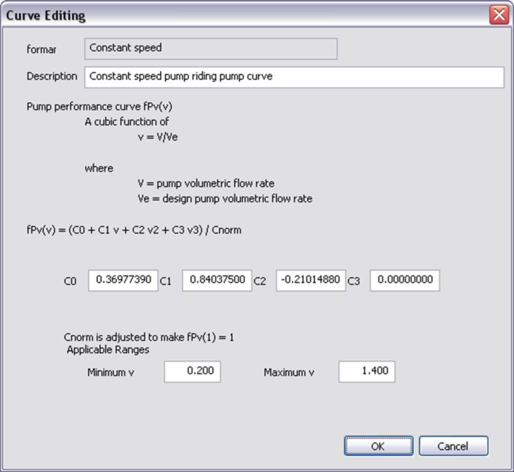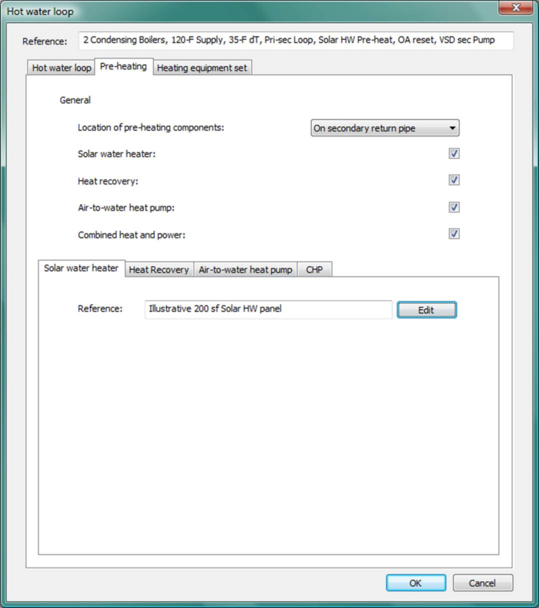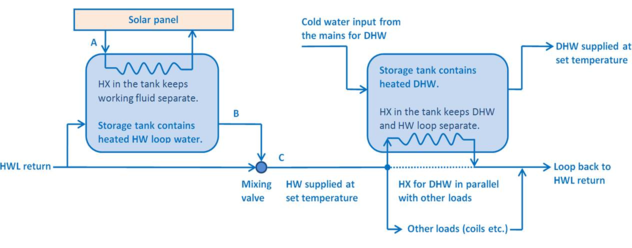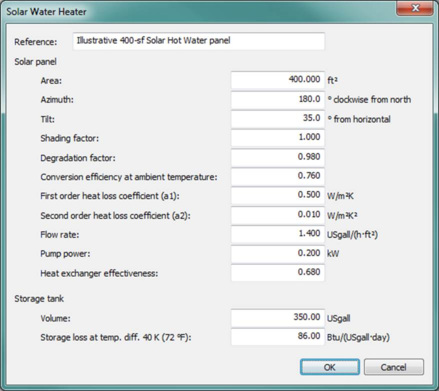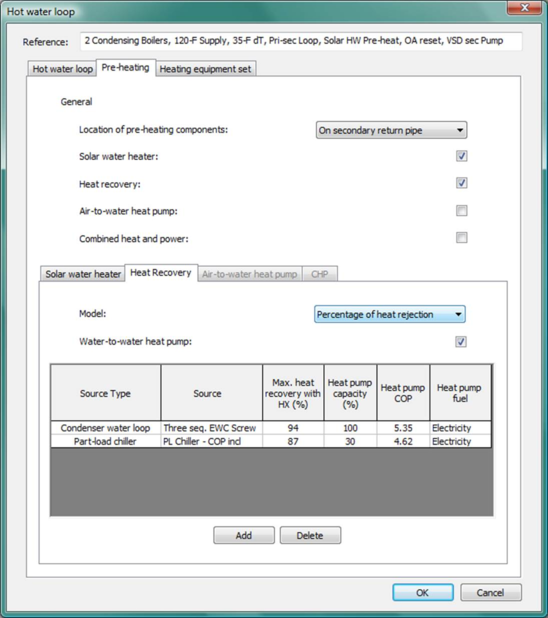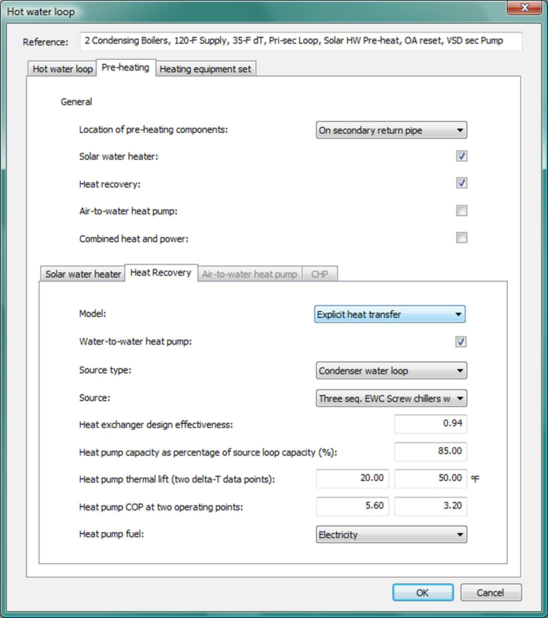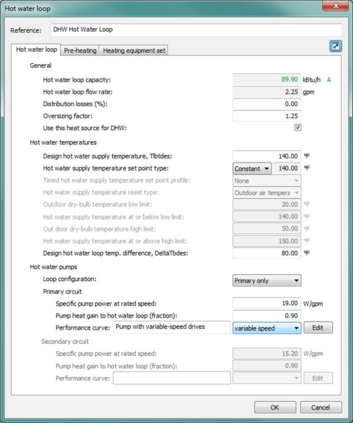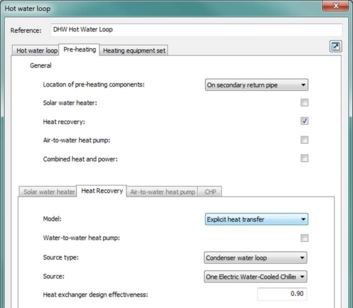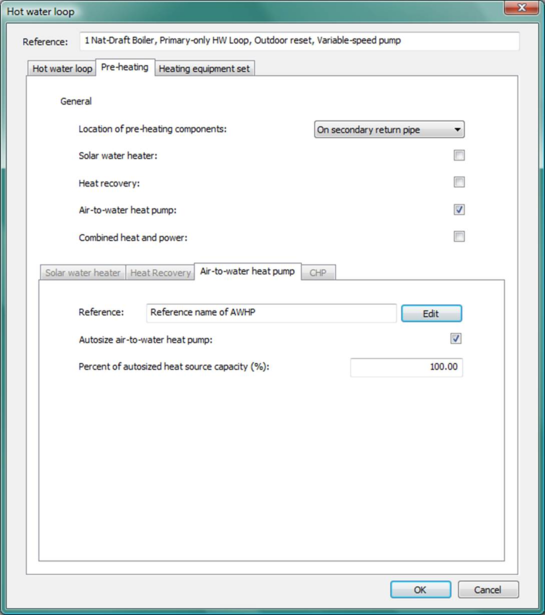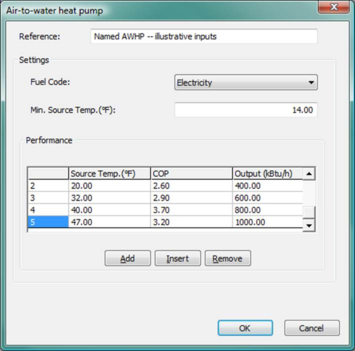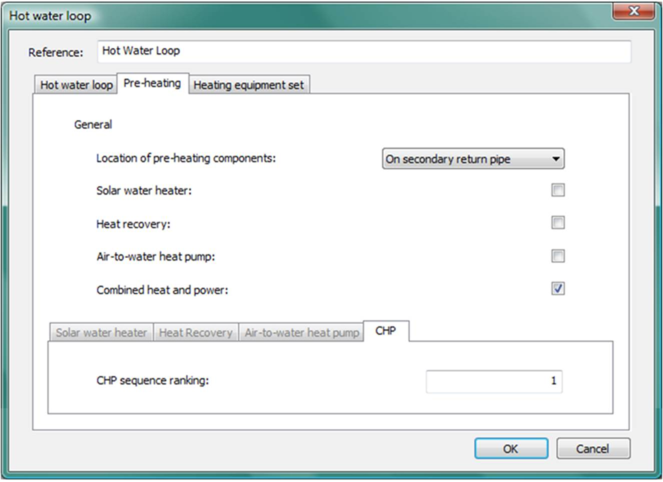Hot Water Loop and Heating Equipment Sequencing
A hot water loop is associated with a sequenced Heating equipment set comprising any number of heating devices, and a number of optional Pre-heating devices or sources with a pre-set sequence and specific locations on the primary and secondary (if used) hot-water loop returns. The Heating equipment set can include any combination of two different heating equipment types:
-
Hot water boiler: uses editable pre-defined curves and other standard inputs, such as efficiency at rated condition, supply temperature, flow rate, and parasitic loads
-
Part load curve heating plant: flexible generic inputs entered in a matrix of load-dependent efficiency and parasitic power—i.e., a data grid with efficiency and pump/parasitic power set relative to maximum and part-load values; can represent any device used to heat water.
The Hot water loop (HWL) heat source can provide heat to any components that present a heating load, with the exception of steam humidifiers, which can be served only by a Generic heat source. Components that can be served by a Hot water loop range from heating coils (both simple and advanced type), radiators, radiant panels, and baseboard heaters to absorption chillers (via Part load curve chiller dialog).
Hot water loops can also be designated to serve domestic hot water (DHW) loads from Apache Systems (DHW loads, tanks, associated losses, and DHW-specific solar HW systems are modeled in Apache Systems; resulting/remaining loads are then passed to ApacheHVAC). To designate a GHS to serve DHW loads, tick the ‘Is DHW served by ApacheHVAC boiler?’ box in the Hot water tab in the Apache Systems dialog, then, in ApacheHVAC, check the ‘Use this heat source for DHW?’ checkbox in the HWL dialog.
Overall sequencing
The sequenced Heating equipment set associated with a Hot water loop meets remaining load after heat available from solar water heating (SWH), condenser heat recovery (CHR), an air-to-water heat pump (AWHP), or combined-heat & power (CHP) system have been fully utilized.
The heating load collectively presented by radiators, heating coils, etc. assigned to a particular hot water loop is summed at each time step to set the required instantaneous output from the hot water loop. An allowance is made for any pipe-work distribution losses.
Heat available from any pre-heating devices (SWH, CHR, AWHP, and CHP) on the hot water loop is first used to meet the imposed load. Finally, any load left after the pre-heating devices are met by loading the sequenced equipment in the Heating equipment set (see Heating equipment set tab of the Hot water loop dialog). The pre-heating sequence on a hot water loop is therefore, assuming all possible pre-heating devices are present, as follows: SWH à CHR à AWHP à CHP à Heating equipment set . Unused pre-heating devices will be skipped in the loading sequence.
Heating capacity and feedback to heating components
If the load on a Hot water loop exceeds the combined capacity of Pre-heating devices and Heating equipment set, the Hot water loop will, for just one simulation time step (e.g., 6 minutes) supply the additional energy required, with efficiency remaining at the value associated with full capacity. However, at the very next simulation time step, any deficiency in overall Hot water loop capacity will result in a reduction of the hot water supply temperature, thus providing feedback to the components served by the loop. In other words, heat sources on a Hot water loop will always attempt to achieve the target supply water temperature. If the target supply water temperature cannot be reached, the components served must attempt to meet heating loads with cooler water. This differs from Generic heat sources, in which case capacity shortages do not feed back to the components served.
Presently (as of VE 6.4.0.5), the adjusted hot water supply temperature affects only certain types of components. Advanced heating coils respond to the adjusted supply temperature by reducing the amount of heat they are able to deliver. Radiators (including radiant panels and baseboard heaters) and zone-level hydronic heating loops are next in line to have this capability. Simple heating coils, and radiators in the current version, do not respond to the adjusted temperature. Their heat output is dictated by autosizing and user inputs within the component dialogs and the conditions on the air-side system or in the building spaces where they reside. Likewise, loads on a Hot water loop associated with domestic hot water and absorption chillers are insensitive to the hot water loop supply water temperature. For the time being, these loads must be constrained on the demand side in order to prevent the Heating equipment set on the hot water loop meeting an overcapacity load condition.
Hot water loop configurations and pump modeling
Two options are offered for the Hot water loop configuration:
· Primary-only: Loop flow is maintained by a primary hot water pump that can be either a variable-speed pump (i.e., using a variable-speed drive) or constant-speed pump riding the pump curve.
· Primary-Secondary: Loop flow is maintained by a combination of primary and secondary pumps. The primary pump is assumed to have constant flow when it is on. The secondary pump can be either a variable-speed pump with VSD or a constant-speed pump riding the pump curve.
For both Hot water loop configurations, when there is only a single boiler operating on the loop (i.e., without any pre-heating devices or other boilers operating), the pump or pumps is/are assumed to operate only when the boiler is operating . In all other cases (i.e., when there are pre-heating devices or multiple boilers operating), the pump operation will be independent of the boiler on/off cycling status.
If a pump has variable flow rates (the primary pump in the Primary-only configuration or the secondary pump in the Primary-Secondary configuration), it will be subject to cycling on/off below the minimum flow rate permitted.
If the pump has a constant flow when it is on (the primary pump in the Primary-Secondary configuration ), this constant flow is multiplied by its specific pump power to determine the pump power. If the pump has variable flow (the primary pump in the Primary-only configuration, or the secondary pump in the Primary-Secondary configuration), i ts design pump power is calculated as the specific pump power multiplied by the design hot water flow rate. The design pump power is then modified by the pump power curve to get the operating pump power.
The required variable flow featured in the pump power curve is calculated as the summation of required flow from all components served by the hot water loop (heating coils, radiators, etc.), subject to the minimum flow the pump permits. Required hot water flow rates for simple heating coils, radiators, absorption chillers, and DHW loads vary in proportion to their heating loads. Required hot water flow rates for advanced heating coils are determined by the detailed heat transfer calculation of the advanced heating coil model (radiators and other zone-level hydronic heating loops and devices are next in line to gain sensitivity to loop temperatures and to provide feedback regarding water flow rates).
Figure 3-9 shows the conceptual hot water loop configuration. A Hot water loop with primary-secondary configuration is illustrated. On the secondary loop, hot water is supplied to heating devices connected in parallel to each other. Loads on the demand side (secondary loop in this illustration) can include: simple heating coils, advanced heating coils, hot water radiators/panels/heaters, hydronic heating loops, absorption chillers, and DHW loads from an Apache System. A solar water heater serving as pre-heating equipment can be included on the return from the demand-side heating devices. As this is connected in series to the heating coils and before the secondary return pipe meets the common pipe, the solar HW heater inlet sees the lowest temperature available in the case of a space heating loop. On the primary loop, heat sources modeled in parallel to each other, and thus each of these sees the primary loop return temperature at its inlet. These are, however, engaged sequentially to raise the hot water return temperature to the hot water supply temperature set point. These heat sources can include: CHR (Condenser heat recovery), AWHP (Air-to-water heat pumps), CHP (Combined heat and power), PLE (Part load curve heating equipment), and HWB (Hot water boilers).
When Primary only is selected as the Hot water loop configuration, this effectively removes the constant-speed primary loop pump and common pipe from the diagram below.
Figure 3 - 9 : Hot water loop diagram: Primary-secondary configuration shown.
Hot water loop distribution losses
Distribution losses from the pipe work are considered as a user-specified percentage of the hot water loop load. Transfer of hot water pump heat gain to the loop is modeled according to a user input fraction for pump and motor heat gain to the hot water loop.
Hot water loop dialog
The hot water loop dialog has three tabs:
· Hot water loop : This tab manages the properties of the hot water loop. It provides inputs for the primary and secondary (if present) hot water loops.
· Pre-heating : This tab manages information used for pre-heating devices (SWH, CHR, AWHP, CHP) on the loop.
· Heating equipment set : This tab provides for the addition, copying, and sequencing of heating equipment (the Heating equipment set), which may be edited with heating equipment dialogs (see section 2.5 and 2.6). Heating equipment sequence ranking for part-load ranges and capacity weightings for autosizing are set here. During simulation, each piece of equipment within the Heating equipment set is engaged according to the user-specified sequence. During autosizing, sequenced heating equipment and the associated water flow rates are sized on the basis of user-specified percentages of the peak design heating load.
Reference name for Hot Water Loop
Enter a description of the component. It is for your use when selecting, organizing, and referencing any component or controllers within other component and controller dialogs and in the component browser tree. These references can be valuable in organizing and navigating the system and when the system model is later re-used on another project or passed on to another modeler. Reference names should thus be informative with respect to differentiating similar equipment, components, and controllers.
Figure 3 - 10 : Hot water loop dialog (shown with the Hot water loop tab selected)
Hot Water Loop tab
The Hot water loop tab facilitates the definition of the hot water temperatures and hot water pumps, together with the distribution losses and oversizing factor for the hot water loop. An option is also provided to designate a hot water loop as the heat source for DHW loads from an Apache system.
Distribution Losses
Enter the hot water loop distribution losses—i.e., the loss due to distribution of heating from the heating plant to point of use—as a percentage of heating demand. The loss entered here does not accrue to the conditioned spaces within the building. Rather, this heat is assumed to be lost to the outdoor to the outdoor environment.
|
Warning Limits (%)
|
0.0 to 20.0
|
|
Error Limits (%)
|
0.0 to 75.0
|
Oversizing Factor
Following ASHRAE Loads autosizing, the factor by which the heating plant size is increased relative to the peak calculated value.
Use This Heat Source for DHW?
Tick this checkbox to designate this HWL to serve DHW loads. Also tick the ‘Is DHW served by ApacheHVAC boiler?’ checkbox in the Hot water tab of an Apache system.
Design Hot Water Supply Temperature, Tlbtdes
Enter the design hot water supply temperature (leaving boiler water temperature).
Hot Water Supply Temperature Set Point Type
Three options are available for hot water supply temperature set point type: Constant, Timed, or Reset.
Constant Hot Water Supply Temperature Set Point
When Constant is selected for hot water supply temperature set point type, this field is automatically set by the program as the design hot water supply temperature.
Timed Hot Water Supply Temperature Set Point Profile
When Timed is selected for hot water supply temperature set point type, select the absolute profile to be applied to the hot water supply temperature set point, which are defined through the APPro facility (the Profiles Database).
Hot Water Supply Temperature Reset Type
When Reset is selected for hot water supply temperature set point type, select the hot water supply temperature reset type. Currently only one option is provided: Outdoor air temperature reset . When Outdoor air temperature reset type is selected, which is the default, you also need to specify three more reset parameters:
· Outdoor dry-bulb temperature low limit
· Outdoor dry-bulb temperature high limit
· Hot water supply temperature at or above high limit
The fourth parameter (Hot water supply temperature at or below low limit) required by Outdoor air temperature reset type is automatically set by the program as the hot water supply temperature at design condition.
Outdoor Dry-bulb Temperature Low Limit
When hot water supply temperature reset type is selected as Outdoor air temperature reset, enter the outdoor dry-bulb temperature low limit to be used by the reset.
Hot Water Supply Temperature at or below Low Limit
When hot water supply temperature reset type is selected as Outdoor air temperature reset, this parameter is automatically set by the program as the hot water supply temperature at design condition and does not need to be specified.
Outdoor Dry-Bulb Temperature High Limit
When hot water supply temperature reset type is selected as Outdoor air temperature reset, enter the outdoor dry-bulb temperature high limit to be used by the reset.
Hot Water Supply Temperature at or above High Limit
When hot water supply temperature reset type is selected as Outdoor air temperature reset, enter the hot water supply temperature at or above the outdoor dry-bulb temperature high limit to be used by the reset.
Design Hot Water Loop Temperature Difference (∆Tbdes)
Enter the design hot water loop temperature difference (∆T bdes )—i.e., the difference between the design hot water supply and return temperatures.
Loop Configuration
Select the loop configuration. Two options are offered: Primary-only and Primary-Secondary.
Primary Circuit Hot Water Specific Pump Power at Rated Speed
Enter the primary circuit hot water specific pump power at rated speed, expressed in W/(l/s) in SI units (or W/gpm in IP units).
If the ‘loop configuration’ is selected as Primary-only:
Primary circuit hot water pump power will be calculated on the basis of variable flow, subject to the constraint that the pump will start cycling below the minimum flow rate it permits. The operating pump power will be based on its design pump power modified by the pump power curve. Its design pump power is calculated as the specific pump power multiplied by the design hot water flow rate. The default value for the specific pump power in this case is the total hot water specific pump power (19 W/gpm) as specified in ASHRAE 90.1 G3.1.3.5.
The required variable flow featured in the pump power curve is calculated as the summation of required flow from all components (heating coils, radiators, etc.) served by the hot water loop, subject to the minimum flow the pump permits. Required hot water flow rates for simple heating coils, radiators, absorption chillers, and DHW loads vary in proportion to their heating loads. Required hot water flow rate for advanced heating coils are determined by the detailed heat transfer calculation of the advanced heating coil model.
If the ‘loop configuration’ is selected as Primary-Secondary:
Primary circuit hot water pump power will be calculated on the basis of constant flow (when it operates). The model will be based on a specific pump power parameter, with a default value of 3.8 W/gpm. The default value is based on the total hot water specific pump power (19 W/gpm) as specified in ASHRAE 90.1 G3.1.3.5 and assuming a 20:80 split between the primary and secondary circuits.
The primary circuit hot water loop flow rate will be calculated from the design heating capacity (Q des ) and the design hot water temperature change ( ∆T bdes ) of the hot water loop.
Primary Circuit Hot Water Pump Heat Gain to Hot Water Loop (fraction)
Enter the primary circuit hot water pump heat gain to hot water loop, which is the fraction of the motor power that ends up in the hot water. Its value is multiplied by the primary circuit hot water pump power to get the primary circuit hot water pump heat gain, which is deducted from the heating load of the hot water loop.
Primary Circuit Hot Water Pump Power Curve, fPv(v)
This field is only active when the ‘loop configuration’ is selected as Primary-only.
If this field is active:
This is the primary circuit hot water pump power curve currently selected. Use the Select button to select the appropriate curve from the system database. Use the Edit button to edit the curve parameters if you like. The Edit button will pop up a dialog displaying the formula and parameters of the curve, allowing the curve parameters to be edited. You are allowed to edit the curve coefficients, in addition to the applicable ranges of the curve independent variables. When editing the curve parameters, it is important that you understand the meaning of the curve and its usage in the model algorithm.
Also be careful that the edited curve has reasonable applicable ranges for the independent variables. A performance curve is only valid within its applicable ranges. In the case the independent variables are out of the applicable ranges you set, the variable limits (maximum or minimum) you specified in the input will be applied.
The primary circuit hot water pump power curve f Pv (v) is a cubic function of
v = V/V e
where
V = pump volumetric flow rate.
V e = design pump volumetric flow rate.
And:
f Pv (v) = (C 0 + C 1 v + C 2 v 2 + C 3 v 3 ) / C norm
where
C 0 , C 1 , C 2 and C 3 are the curve coefficients
C norm is adjusted (by the program) to make f Pv (1) = 1
The primary circuit hot water pump power curve is evaluated for each iteration of the hot water loop, for each time step during the simulation. The curve value is multiplied by the design primary hot water pump power to get the operating primary pump power of the current time step, for the current fraction of pump volumetric flow rate. The curve should have a value of 1.0 when the operating pump volumetric flow rate equals rated pump volumetric flow rate (v = 1.0).
Figure 3 - 11 : Edit dialog for the primary circuit hot water pump power curve (values for constant-speed pump are shown)
Secondary Circuit Hot Water Specific Pump Power at Rated Speed
This field is only active when the ‘loop configuration’ is selected as Primary-Secondary.
If this field is active:
Enter the secondary circuit hot water specific pump power at rated speed, expressed in W/(l/s) in SI units (or W/gpm in IP units). The default value (15.2 W/gpm) is based on the total hot water specific pump power (19 W/gpm) as specified in ASHRAE 90.1 G3.1.3.5 and assuming a 20:80 split between the primary and secondary circuits.
Secondary circuit hot water pump power will be calculated on the basis of variable flow, subject to the constraint that the pump will start cycling below the minimum flow rate it permits. The operating pump power will be based on its design pump power modified by the pump power curve.
Its design pump power is calculated as the specific pump power multiplied by the design hot water flow rate. The design secondary circuit hot water loop flow rate is assumed equal to the design primary circuit hot water loop flow rate, which is calculated from the design heating capacity (Q des ) and the design hot water temperature change ∆T bdes .
The required variable flow featured in the pump power curve is calculated as the summation of required flow from all components (heating coils, radiators, etc.) served by the hot water loop, subject to the minimum flow the pump permits. Required hot water flow rates for simple heating coils, radiators, absorption chillers, and DHW loads vary in proportion to their heating loads. Required hot water flow rate for advanced heating coils are determined by the detailed heat transfer calculation of the advanced heating coil model.
Secondary Circuit Hot Water Pump Heat Gain to Hot Water Loop (fraction)
This field is only active when the ‘loop configuration’ is selected as Primary-Secondary.
If this field is active:
Enter the secondary circuit hot water pump heat gain to hot water loop, which is the fraction of the motor power that ends up in the hot water. Its value is multiplied by the secondary circuit hot water pump power to get the secondary circuit hot water pump heat gain, which is deducted from the heating load of the hot water loop.
Secondary Circuit Hot Water Pump Power Curve, fPv(v)
This field is only active when the ‘loop configuration’ is selected as Primary-Secondary.
If this field is active:
This is the secondary circuit hot water pump power curve currently selected. Use the Select button to select the appropriate curve from the system database. Use the Edit button to edit the curve parameters if you like. The Edit button will pop up a dialog displaying the formula and parameters of the curve, allowing the curve parameters to be edited. You are allowed to edit the curve coefficients, in addition to the applicable ranges of the curve independent variables. When editing the curve parameters, it is important that you understand the meaning of the curve and its usage in the model algorithm.
Also be careful that the edited curve has reasonable applicable ranges for the independent variables. A performance curve is only valid within its applicable ranges. In the case the independent variables are out of the applicable ranges you set, the variable limits (maximum or minimum) you specified in the input will be applied.
The secondary circuit hot water pump power curve f Pv (v) is a cubic function of
v = V/V e
where
V = pump volumetric flow rate.
V e = design pump volumetric flow rate.
and
f Pv (v) = (C 0 + C 1 v + C 2 v 2 + C 3 v 3 ) / C norm
where
C 0 , C 1 , C 2 and C 3 are the curve coefficients
C norm is adjusted (by the program) to make f Pv (1) = 1
The secondary circuit hot water pump power curve is evaluated for each iteration of the hot water loop, for each time step during the simulation. The curve value is multiplied by the design secondary hot water pump power to get the operating secondary pump power of the current time step, for the current fraction of pump volumetric flow rate. The curve should have a value of 1.0 when the operating pump volumetric flow rate equals rated pump volumetric flow rate (v = 1.0).
Figure 3 - 12 : Edit dialog for the secondary circuit hot water pump power curve (values for constant-speed pump are shown)
Pre-heating tab
The Pre-heating tab ( Figure 3-13 below) manages information used for possible pre-heating devices (SWH, CHR, AWHP, CHP) on the hot water loop.
Figure 3 - 13 : Pre-heating tab on Hot water loop dialog showing all possible pre-heating options. These are accessed and edited via the tabs at the bottom of the dialog, which include Edit buttons to open nested dialogs for the Solar water heater and Air-to-water heat pump models.
Location of Pre-heating Components
This is simply currently informational, given that only one option is provided: On secondary return pipe. As additional options are added, this will be used to select the location of pre-heating components on the hot water loop (e.g., primary vs. secondary return).
Solar water heater
Solar water heater can be used as a pre-heating device on a hot water loop. When present, the solar water heater will be the first-loaded device to cover the load imposed on the hot water loop. Solar water heater on a hot water loop functions just like the solar water heater available for DHW heating in an Apache System (see Apache Thermal User Guide); however, the relationship to the hot water loop should be understood, as this is not present in Apache Thermal.
Figure 3 - 14 : Solar water heater on hot water loop (HWL) with domestic hot water (DHW) in ApacheHVAC.
Return water from the HWL enters the storage tank at left. The mixing valve at point “C” provides the set HW supply temperature to the extent feasible with the solar heated water exiting the storage tank at “B.” When the HWL is assigned to be the source of heat for domestic hot water (DHW), a heat exchanger is added in parallel with other loads (coils, etc.) on the HWL.
In contrast to the Apache Thermal version of the solar water heater wherein cold water from the mains is fed the storage tank directly, without a bypass or mixing valve, and the tank temperature is constrained to the set supply temperature, in ApacheHVAC the solar water heater model allows for the solar panel to continue adding heat to the tank until it can no longer do so because there is no useful delta-T or the tank reaches the fixed upper limit of 95°C—a temperature that the panel will not likely ever achieve. Therefore, the temperature at point “B” can actually be much hotter than the HWL, especially if the HWL is being used for relatively low temperature system, such as heated floors. The bypass/mixing valve determines the supply temperature downstream of the tank at point “C”.
The HWL solar htg loop input results variable (Solar water heater input to tank in Vista Pro ApacheHVAC Component variables) is taken at point “A.” This heat input from the solar panel to the solar storage tank can be affected by several factors, including: solar radiation; solar panel efficiency; storage tank capacity, temperature, and thermal losses; HWL secondary return temperature, the target HWL supply temperature, and variability of loop loads. Point “C” corresponds to the results variable ApHVAC total HWL solar heat input, which indicates the heat that was added to the HWL from the solar water heater.
In ApacheHVAC, a HWL with or without the solar water heater may be used for heating DHW, but this aspect of the right side of the diagram is fully optional, as with any other load on the loop. While the DHW-coupled Solar HW configuration in the Apache Thermal view is more common for residential applications, commercial applications often have very little DHW demand, and thus tend more often to use the solar hot water for space heating. Hybrid systems are also feasible.
The presence of Solar Hot Water equipment on the HWL return in ApacheHVAC does not negate the use of the separate Solar HW module in Apache Thermal view. And, the two can be combined, such that the Solar HW model in Apache Thermal view is first in line to meet DHW load, thus take advantage of the greater delta-T between main water supply and the solar HW loop for improved solar HW efficiency. Any remaining load is then passed on to the HWL in ApacheHVAC by ticking the box after “Is DHW served by ApacheHVAC boiler?” in the Apache Systems dialog.
Solar water heater checkbox
Tick this checkbox to specify a solar water heater as a pre-heating device on the heat transfer loop. Ticking or un-ticking this checkbox will enable or disable the associated Solar water heater tab below.
Solar water heater tab
This tab simply displays the reference of the solar water heater and associated Edit button.
Solar water heater reference
This displays the reference of the solar water heater associated with this hot water loop. It is editable in the solar water heater dialog, which is opened by clicking the Edit button to the right of this field.
Solar water heater Edit button
This opens the solar water heater dialog for editing of all solar water heater parameters. See
Figure 3 - 15 : Solar water heater edit dialog with illustrative inputs.
Area: Aperture area of the solar panel (m2 or ft2).
Azimuth: Panel azimuth angle in degrees clockwise from north.
Tilt: Panel tilt angle in degrees from horizontal.
Shading factor: If the solar panel is shaded by buildings or other objects the average shading effect can be modelled by reducing the shading factor from the default value of 1.
Degradation factor: This factor accounts for the effects of soiling and aging of the panel.
Conversion efficiency at ambient temperature (η 0), first order heat loss coefficient (a 1), and second order heat loss coefficient (a 2)
Solar hot water panel data expresses the performance of the device in terms of conversion efficiency at ambient temperature, η 0, and two heat loss coefficients, a 1 and a 2. The heat output of the device is described by the following equation using these coefficients:
W = η0 I – a1(T-Ta) – a2(T-Ta)2
where
W = heat output per unit panel area
I = incident solar irradiance, after allowing for shading and degradation (W/m2)
T = panel temperature ( °C)
Ta = outside air temperature ( °C)
a1 = first-order heat loss coefficient ( W/m2 K)
a2 = second-order heat loss coefficient ( W/m2 K)2
Values for η 0 , a 1 and a 2 are generally available from solar panel manufacturers.
Flow rate - The fluid flow rate through the solar panel, expressed per unit panel area. A figure of 50 l/(h.m2) or roughly 1.3 US gal/(hr·ft2) is typical.
Pump power - The rated power of the pump within the solar water heating system.
Heat exchanger effectiveness - The model assumes the storage tank is heated from the collector loop by a heat exchanger of some kind, either an internal coil or an external exchanger. The heat exchanger effectiveness is the ratio of the temperature drop across the heat exchanger on the collector loop side to the maximum theoretical temperature drop (which would bring the collector loop fluid down to the tank temperature).
Storage tank Volume - Volume of the storage tank, which is used to calculate storage tank thermal losses.
Storage loss at temp. diff. 40 K (72°F)
The DHW storage tank loss factor (kWh/l/day or Btu/(USgal·day)). This is used with the storage tank volume to calculate tank losses.
The following tables from SAP (2005) may be helpful in setting this parameter.
|
Table 2: Hot water storage loss factor (kWh/(l.day)
|
|
|
Cylinder loss factor (L) kWh/(l.day)
|
|
Insulation thickness (mm)
|
Factory insulated cylinder
|
Loose jacket
|
|
0
|
0.1425
|
0.1425
|
|
12
|
0.0394
|
0.0760
|
|
25
|
0.0240
|
0.0516
|
|
35
|
0.0191
|
0.0418
|
|
38
|
0.0181
|
0.0396
|
|
50
|
0.0152
|
0.0330
|
|
80
|
0.0115
|
0.0240
|
|
120
|
0.0094
|
0.0183
|
|
160
|
0.0084
|
0.0152
|
Alternatively the heat loss factor, L, may be calculated for insulation thickness of t mm as follows:
1) Cylinder, loose jacket L = 0.005 + 1.76/(t + 12.8)
2) Cylinder, factory insulated L = 0.005 + 0.55/(t + 4.0)
|
Table 2a: Volume factor for cylinders and storage combis
|
|
Volume Vc
|
Volume Factor Vf
|
Volume Vc
|
Volume Factor Vf
|
|
40
|
1.442
|
180
|
0.874
|
|
60
|
1.259
|
200
|
0.843
|
|
80
|
1.145
|
220
|
0.817
|
|
100
|
1.063
|
240
|
0.794
|
|
120
|
1.000
|
260
|
0.773
|
|
140
|
0.950
|
280
|
0.754
|
|
160
|
0.908
|
When using the data in Table 2, the loss is to be multiplied by the volume factor in Table 2a.
2) Alternatively, the volume factor can be calculated using the equation
VF = (120 / Vc )1/3
Where:
Vc – volume of cylinder or storage (liters)
Heat recovery
Heat recovery can be modeled as either a heat exchanger or water-to-water heat pump between loops, and there are two options described below for modeling heat recovery effectiveness. Most often, but not always, the recovered heat is from a condenser water loop for cooling equipment, and in that case referred to as condenser heat recovery (CHR). When enabled within the Hot water loop dialog, it serves heating loads ahead of all but one of the heat sources for that HW loop; the hard-wired sequence is for serving the assigned loads is SWH à CHR à AWHP à CHP à Heating equipment set .
There are two heat exchanger and water-water heat pump (WWHP) model options for heat recovery when the recipient is a Hot water loop: a simple fixed-percentage effectiveness heat exchanger and fixed-COP heat pump or an explicit model with heat exchanger effectiveness and heat pump COP varying according to the loop water temperatures.
· Percentage of heat rejection heat-exchanger model
This simple heat-exchanger model is essentially the same as the heat recovery model provided in pre-v6.5 versions. It models the heat recovery as a simple percentage of the source heat rejection. The percentage represents a fixed heat-exchanger effectiveness.
· Fixed-COP water-source heat pump model
The temperature for the recovered heat can be upgraded with a water-to-water or water-source heat pump (WSHP)—e.g., from 90°F to 140°F. This would typically be used when serving space-heating loads such as direct (DX-based) heating of supply air or hot water for heating coils and baseboard heaters that require higher temperatures than normally available via a simple heat exchanger on the condenser water loop. The Percentage of heat rejection model can be used regardless of whether there is explicit modeling of the loop water temperatures on the heat recovery source and recipient sides.
· Explicit heat transfer :
This option models the heat transfer between the heat recovery source and recipient loops using an explicit water-to-water heat exchanger, which modulates the heat exchanger effectiveness for off-design temperature differences across the heat exchanger. Users enter an effectiveness value for the design condition—i.e., when the source loop (leaving the condenser) and recipient loop (return from loads) are at their design temperatures. Based on this single data point, the model determines effectiveness for all other loop temperature combinations during simulation.
· Variable-COP water-source heat pump model
In the explicit heat transfer model, the water-to-water heat pump (WWHP) used to upgrade recovered heat modulates COP in response to the temperature difference or “thermal lift” between the heat recovery source loop and the heat recovery recipient loop at each simulation time step. This relatively simple model uses linear interpolation to vary the COP between two user-input COP values corresponding to two heat pump operation points (low & high thermal lift). The Explicit heat transfer model can be used only when there is explicit modeling of the loop water temperatures on the heat recovery source and recipient sides.
Capacity for the Heat Recovery WWHP is now limited to a user-specified percentage of the heat recovery source capacity, whereas in pre-v6.5 versions WWHP capacity was a percentage of the instantaneous load on the source. This revised limit has been introduced in both of the WWHP models described above in order to provide a more realistic basis for the capacity. This avoids recovering more heat with the WWHP than would be possible (or desirable) in practice. Without this constraint the WWHP could entirely displace the boilers on a HWL, which might not be what the user intends or expects.
Heat recovery sources and recipients
All heat recovery data are now displayed, edited, and stored on the recipient side ( Figure 3-16 and Figure 3-17 , below).
Heat recovery sources can be either a part-load-curve “chiller” model (which may represent something other than a water-cooled chiller) or a condenser water loop serving one or more electric water-cooled chillers. Future versions will expand on the range of possible sources, for example, allowing the heat-transfer loop to be selected as a source. Heat recovery recipients can be a generic heat source, a hot water loop, or a heat transfer loop.
When the Percentage of heat rejection model is used, there can be multiple heat recovery sources linked to one recipient. This is among the reasons that the sources are now specified in the recipient dialog. Source types can be any combination of condenser water loops and/or part-load curve chiller models. Each heat recovery source can be linked to just one heat recipient.
When the Explicit heat transfer model is used, there can be only one heat recovery source linked to a given recipient loop, and the source type is limited to condenser water loops.
The heat recovery recipient is displayed on the source side (Heat recovery sub-tab within the Heat Rejection tab of the Chilled water loop dialog and in the Part-load curve chiller model dialog) for user’s information only. Each heat recovery source can be linked to only one heat recovery recipient.
Figure 3 - 16 : Heat Recovery tab within the Hot water loop dialog (top) using the Percentage of heat rejection model with water-to-water heat pump and illustrative inputs for source, percentage heat recovery, and WWHP performance. Also shown (below the Hot water loop dialog), the Condenser heat recovery recipient designation is displayed within the Heat rejection tab of the Chilled water loop dialog.
Figure 3 - 17 : Heat Recovery tab within the Hot water loop dialog (top) using the Explicit heat transfer model with water-to-water heat pump and illustrative inputs for source, heat exchanger effectiveness, and WWHP performance. Also shown (below the Hot water loop dialog), the Condenser heat recovery recipient designation is displayed within the Heat rejection tab of the Chilled water loop dialog.
Heat recovery checkbox
Tick this checkbox to specify Heat recovery as a heat source on the hot water loop. Ticking or un-ticking this checkbox will enable or disable the associated Heat Recovery sub-tab below.
Heat recovery model
Choose the desired heat recovery model type. Two model types are provided: Percentage of heat rejection and Explicit heat transfer.
If Percentage of heat rejection is selected, you will be able to specify multiple heat recovery sources contributing to the same hot water loop (the heat recovery recipient), listed in a source table below, together with other parameters required by the Percentage of heat rejection model. For each heat recovery source row in the table, these column fields are displayed: Source type, Source, Max. heat recovery with HX (%, as percentage of source loop load), Heat pump capacity (%, as percentage of source loop capacity), Heat pump COP, and Heat pump fuel. In this case, a heat recovery source can be added or removed using the Add or Delete button below the source table. Double clicking any active cell within the source table provides editing access to that specific cell.
If Explicit heat transfer is selected, you will be able to specify only one heat recovery source contributing to the hot water loop (the heat recovery recipient), together with other parameters required by the Explicit heat transfer model.
Water-to-water heat pump checkbox
The heat recovered from the heat recovery source(s) may be upgraded using a water-to-water heat pump (See additional explanation above). Specify this mode of operation by ticking the Water-to-water heat pump checkbox.
Source type
Choose the heat recovery source type for a particular source.
For the Percentage of heat rejection model, Source type is listed in the first column of the source table. Double clicking a cell in this column allows you to choose the source type from two options: Condenser water loop or Part load chiller.
For the Explicit heat transfer model, Source type is selected from the Source type combo box, currently with one available option: Condenser water loop (other sources may be available in a future release).
When source type is Condenser water loop, this is referring to a condenser water loop associated with a currently defined chilled water loop, thus the chilled water loop Reference name will be the source name.
When source type is Part load chiller, this is referring to any currently defined part load chiller either on a chilled water loop or separately defined as a Generic cooling source.
Source
Choose the heat recovery source name for a particular source.
For the Percentage of heat rejection model, Source is listed in the second column of the source table. Double clicking a cell in this column allows you to choose the source from a drop-down list of available sources currently defined in the HVAC system file.
For the Explicit heat transfer model, use the Source drop-down list on the right hand side of the dialog to select from available sources currently defined in the HVAC system file.
Note that for both heat recovery models, only current available sources defined in the HVAC file will be included in the drop-down list:
· If the selected Source type is Condenser water loop, ‘available’ means the listed chilled water loop has a condenser water loop (Condenser water loop box on Heat rejection tab is ticked) and has not been specified as a heat recovery source for any other heat recovery recipient.
· If the selected Source type is Part-load chiller, ‘available’ means the defined part-load chiller has not been specified a heat recovery source for any other heat recovery recipient.
On switching the model option from Percentage of heat rejection to Explicit heat transfer, no more than one source will remain active and displayed (and this should not be a part load curve chiller). If there are multiple sources specified prior to the switch and these include more than one valid source for the Explicit heat transfer option, then the first valid source for the Explicit heat transfer option will remain; other specified sources will be removed. If prior to the switch, there are only part load curve chillers specified as sources, then upon switching the Source drop-down list will be set to <None>.
For a specified heat recovery source, its recipient will be displayed in the corresponding source dialog for information only.
Max. heat recovery with HX (%)
This parameter is only required by the Percentage of heat rejection model. When Percentage of heat rejection model is used, this field (in the 3rd column of the source table) represents the percentage of the source heat rejection (from either a condenser water loop or a part load chiller) that is subject to heat recovery using a heat exchanger.
In this case, the amount of heat recovered at any given time is given by:
Where, Q l is the load on the electric water-cooled chiller(s) if the heat recovery source is a condenser water loop (or the load on the part load curve chiller if the source is from a part load chiller), Q c is the compressor power for the chiller(s) and p is heat recovery percentage.
Heat exchanger design effectiveness
This parameter is required only by the Explicit heat transfer model. This is effectiveness of the heat recovery water-to-water heat when using the Explicit heat transfer model exchanger and when both the source and recipient loop are operating at user specified design loop temperatures. Effectiveness at any given time step will
Heat pump capacity (%)
This field is enabled only when the Water-to-water heat pump checkbox is ticked—i.e., when a water-to-water heat pump is being used to upgrade the heat recovered from the source(s). When active, enter the capacity for the desired water-to-water heat pump, as a percentage of the source loop capacity. This is used to limit the capacity of the water-to-water heat pump. When heat recovery source is a condenser water loop: the source loop capacity is the cooling tower or fluid cooler capacity (the condenser water loop capacity). When heat recovery source is a part load chiller: the source loop capacity is the part load chiller heat rejection capacity.
For the Percentage of heat rejection model, double clicking a cell in the heat pump capacity column of the source table allows you to edit its value.
For the Explicit heat transfer model, heat pump capacity is edited in the field labeled Heat pump capacity as percentage of source loop capacity.
Heat pump thermal lift (two delta-T data points)
This field is available with the Explicit heat transfer model and is enabled only when the Water-to-water heat pump checkbox is ticked—i.e., when a water-to-water heat pump is used to upgrade the recovered heat as appropriate when the recipient loop is or may become warmer than the source loop. When active, enter the two Heat pump thermal lift parameters for the desired water-to-water heat pump (two delta-T data points: low, high). The thermal lift of the WWHP is the difference between the heat recovery source-side loop temperature before any heat is extracted and the recipient-side loop water temperature after the heat recovery contribution (which will ideally be the target supply water temperature of the recipient loop). During simulation, linear interpolation will be applied to 1/COP using the two heat pump COP values (see below) corresponding to the two specified thermal lift values (low, high) entered here.
Heat pump COP
This field is enabled when the Water-to-water heat pump checkbox is ticked—i.e., when a water-to-water heat pump is used to upgrade the heat recovered from the source(s). When active, enter the COP(s) for the desired water-to-water heat pump.
For the Percentage of heat rejection model, double clicking a cell in the heat pump COP is listed in the 5th column of the source table. this column allows you to manually edit its value, which should normally be the COP for this equipment when the source loop and recipient loop are at design temperatures; however, this may differ for some system designs. In this case, the specified COP is applied as a constant for a WWHP coupled to a specific heat recovery source during simulation.
For the Explicit heat transfer model, the editable values for Heat pump COP at two operating points correspond to the two Heat pump thermal lift values (two use-input delta-T data points described above). For this model, the WWHP COP varies during the simulation with changes in thermal lift between the heat recovery source loop and the heat recovery recipient loop: linear interpolation is applied to 1/COP using the two heat pump COP values corresponding to the two specified operation data points (low, high).
Heat pump fuel or energy source
This field is enabled only when the Water-to-water heat pump checkbox is ticked. When active, select the fuel, type of energy source, or energy end-use category for the water-to-water heat pump. For scratch-built systems, this will normally be Electricity and for pre-defined systems from the HVAC library this is set by default to Heating (electricity), which is an end-use designation for display in Vista Results and for inclusion in the ASHRAE 90.1 Performance Rating Method reports.
For the Percentage of heat rejection model, heat pump fuel is listed in the last column of the source table. Double clicking a cell in this column allows you to choose the heat pump fuel for the desired water-to-water heat pump coupled to a specific heat recovery source.
For the Explicit heat transfer model, heat pump fuel is simply selected from the drop-down list.
Heat pump fuel or energy source
DHW preheating option for ASHRAE 90.1 section 6.5.6.2. requires using the simpler percentage-based model for Condenser Heat Recovery (and not the explicit heat transfer model). Until we add capability for modeling the entering mains water temperature on the other side of the HX for the purpose of DHW pre-heat in ApacheHVAC, using the percentage-based CHR model will be the only solution. Note also that, because the mains temperature is normally on the order of 60 deg F, sometimes cooler, and the condenser loop temperature is normally on the order of 80 to 85 deg F, the recoverable percentage of condenser loop heat will tend to be very high---mainly a function of the water-water heat exchanger effectiveness at design conditions, and not significantly influenced by variations in delta-T.
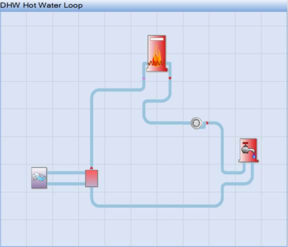
If more refined accounting of the recoverable heat for DHW pre-heating is required under the current scheme, it is necessary to set up a separate Hot Water Loop to serve DHW loads, and then set the SWT and loop Delta-T such that the return water temperature = mains water temperature. For example, if DHW were to be supplied at 140 F, then setting that SWT with a delta-T of 80 F would provide a simulated entering water temperature of 60 F at the explicitly modeled CHR heat exchanger. This will then accurately account for the heat that can be recovered as the condenser loop temperature varies (but will assume a constant 60 F temperature for the mains).
Autosizing this loop will require temporarily assigning a hot-water coil with a very small load to the DHW loop. The coil load will trigger the autosizing of the loop, however, so long as it is very small relative to the DHW loads, the loop flow rate and boiler will be sized to meet the DHW loads.
The dialog above is shown before autosizing with “Use this heat source for DHW” box checked and the example DHW-only loop settings entered. The variable speed pump is selected so that the return water temperature can be constant in accordance with SWT and delta-T, and not varying according to load.
The Explicit heat transfer heat exchanger model on the DHW-only HW loop will then see the SWT minus the loop delta-T as the entering source water temperature for the potable water mains supply.
Air-to-water heat pump
An Air-to-water heat pump (AWHP) can be used as a pre-heating device on the hot water loop. When present, the Air-to-water heat pump will be the first in line to meet assigned loads. The following loading sequence is pre-set for all Hot water loops: SWH à CHR à AWHP à CHP à Heating equipment set.
Figure 3 - 18 : Pre-heating tab on Hot water loop dialog with the Air-to-water heat pump sub-tab selected .
Air-to-water heat pump checkbox
Tick this checkbox to specify an Air-to-water heat pump as a heating device on the hot water loop. Ticking or un-ticking this checkbox will enable or disable the associated Air-to-water heat pump sub-tab below.
The input parameters for Air-to-water heat pumps are described in section 3.6.2
Air-to-water heat pump reference
This displays the reference name of the Air-to-water heat pump associated with this hot water loop. It is not editable directly in the HWL dialog and should be edited in the Air-to-water heat pump dialog, which is opened by clicking the Edit button to the right of this field.
The Edit button opens the Air-to-water heat pump dialog.
Figure 3 - 19 : Air-to-water heat pump dialog with illustrative inputs (described in section 3.6.2 ).
Autosize air-to-water heat pump?
Tick this checkbox to autosize the associated Air-to-water heat pump during a system sizing run.
When this box is ticked, the peak Hot water loop capacity determined by autosizing will be multiplied by the Percent of autosized heat source capacity (%) (see below) to determine the Air-to-water heat pump capacity. The resultant maximum heat pump capacity value will then be used to update the part-load capacity (output) values in the Air-to-water heat pump dialog: The autosizing will reset the value in the bottom row and proportionally adjust all other values to maintain their relationships as load fractions.
Note that the capacity fraction assigned to the heat pump is not subtracted from the hot water loop capacity. In other words, the air-to-water heat pump size will not influence the size of the hot water loop.
Percent of autosized heat source capacity (%)
During a system sizing run, if the ‘Autosize air-to-water heat pump?’ checkbox (see above) is ticked, the sized hot water loop capacity will be multiplied by the value in this field to get the heat pump capacity. The resultant heat pump capacity will then be used to update the air-to-water heat pump capacity in the normal way (re-set the value in the bottom row and adjust all other to maintain proportional relationships in the heat pump data lines).
Once the hot water loop has been sized, edits made in this field will lead to automatic dynamic updating of the heat pump capacity and adjusting of all other data lines in the associated heat pump dialog, based on the hot water loop capacity.
Note that the capacity fraction assigned to the heat pump is not subtracted from the hot water loop capacity. In other words, the Air-to-water heat pump size will not influence the Hot water loop sizing.
Combined heat & power
Heat available from a Combined heat and power (CHP) system can be used as a heat source on the hot water loop. When present, heat available from the CHP system will be used to cover loop heating load prior to engaging the Heating equipment set on the Hot water loop, according to the following loading sequence: SWH à CHR à AWHP à CHP à Heating equipment set . A CHP system is defined within the CHP section of the Renewables dialog in the Apache Thermal view.
Figure 3 - 20 : Pre-heating tab on Hot water loop dialog with the CHP sub-tab selected.
Combined heat and power checkbox
Tick this checkbox to specify Combined heat and power (CHP) system as a heat source on the hot water loop. Ticking or un-ticking this checkbox will enable or disable the associated CHP sub-tab below.
CHP sequence ranking
CHP sequence ranking determines the sequence in which heat available from CHP is used to cover heating loads imposed on the specified heat sources. Heat sources (Generic, Hot water loop, or Heat transfer loop) with lower values of this parameter will receive available heat from CHP before those with higher values. If two ApacheHVAC heat sources have the same sequence ranking in this field, they will simultaneously receive available heat from the CHP system defined in Apache Thermal until either the loads are met or the CHP resource is fully utilized.
Heating Equipment Set tab
The Heating equipment set tab ( Figure 3-21 , below) facilitates the definition of the heating equipment serving the hot water loop. Heating equipment can be added, edited, copied and removed from the existing heating equipment list (the first column of the sequencing table). Heating equipment can also be imported from an existing hot water loop using the Import button.
Figure 3 - 21 : Heating equipment set tab on Hot water loop dialog with illustrative boiler sequencing
A heating equipment sequencing table is provided to set the order in which heating equipment are turned on within any particular load range and to set the relative weighting of autosized capacities. Tick boxes are provided to activate up to 5 load ranges for sequencing and the cells with white background can be edited by double clicking. The cells containing heating equipment names in the heating equipment list column provide access to editing individual heating equipment.
Heating Equipment Model Type to Add
This selection determines the type of heating equipment model to be added when clicking the Add button. Currently two model types are available: part load curve heating plant and hot water boiler.
The Heating equipment set can include any combination of two different heating equipment types:
· Hot water boiler: uses editable pre-defined curves and other standard inputs, such as efficiency at rated condition, supply temperature, flow rate, and parasitic loads
· Part load curve heating plant: flexible generic inputs entered in a matrix of load-dependent efficiency and parasitic power—i.e., a data grid with efficiency and pump/parasitic power set relative to maximum and part-load values; can represent any device used to heat water
Heating equipment List
The heating equipment list column lists the heating equipment in the Heating equipment set for the current Hot water loop. Up to 99 separate pieces of heating equipment can be listed and sequenced. To open the Edit dialog for any particular heating equipment, double-click a heating equipment name on the list or select a heating equipment item and click the Edit button.
Heating equipment Type
The heating equipment type column indicates the model type for each piece of equipment on the list. The types are determined when the heating equipment is added.
PLE = Part-load equipment
HWB = Hot-water boiler
Part Load Range (up to %)
The part load range (%) values can be edited, with the exception of the last value (100%). Up to five part-load ranges can be set. Apart from unused columns—those with no check in the box at the bottom of the column, and thus grayed-out values—part load range values must always increase from left to right.
Heating equipment Sequence Rank
Heating equipment sequence ranks are entered in the body of the table, for each heating equipment and for each part load range. These are integers in the range of 0 to 99 that determine the order in which heating equipment will be engaged during simulation. Within a specific part load range, heating equipment with lower sequence rank will be engaged first. At least one piece of heating equipment should have a nonzero sequencing rank in every column.
When multiple heating equipment are specified to have the same sequence rank for a part load range, they will be engaged simultaneously within that part load range and will share the loop load in proportion to their design capacities.
Within any range (except the last), if all the specified heating equipment are operating at maximum output, the sequencing moves to the next range.
Note: If the load on a Hot water loop exceeds the combined capacity of Pre-heating devices and Heating equipment set, the Hot water loop will, for just one simulation time step (e.g., 6 minutes) supply the additional energy required, with efficiency remaining at the value associated with full capacity. However, at the very next simulation time step, any deficiency in overall Hot water loop capacity will result in a reduction of the hot water supply temperature, thus providing feedback to the components served by the loop. In other words, heat sources on a Hot water loop will always attempt to achieve the target supply water temperature. If the target supply water temperature cannot be reached, the components served must attempt to meet heating loads with cooler water. This differs from Generic heat sources, in which case capacity shortages do not feed back to the components served.
Presently (as of VE 6.4.0.5), the adjusted hot water supply temperature affects only certain types of components. Advanced heating coils respond to the adjusted supply temperature by reducing the amount of heat they are able to deliver. Radiators (including radiant panels and baseboard heaters) and zone-level hydronic heating loops are next in line to have this capability. Simple heating coils, and radiators in the current version, do not respond to the adjusted temperature. Their heat output is dictated by autosizing and user inputs within the component dialogs and the conditions on the air-side system or in the building spaces where they reside. Likewise, loads on a Hot water loop associated with domestic hot water and absorption chillers are insensitive to the hot water loop supply water temperature. For the time being, these loads must be constrained on the demand side in order to prevent the Heating equipment set on the hot water loop meeting an overcapacity load condition.
Heating Equipment Autosizing Capacity Weighting
Heating equipment autosizing capacity weighting is a column of values indicating the relative proportion of the load that each piece of heating equipment will take during autosizing. If the rightmost sequence rank is zero for any heating equipment, the corresponding autosizing capacity weighting will be set automatically to zero. Any heating equipment with a zero autosizing capacity weighting will not be autosized. The Distribute as % button normalizes the autosizing capacity weightings so that they sum to 100. When all the autosizing weightings are zero the Distribute as % button is disabled. It is not obligatory to use the Distribute as % button, as the values will be normalized automatically when applied.
Active Sequence Columns
Under each part load range column of the heating equipment sequencing table (except the 100% column), there is a checkbox indicating the current status of the column. These checkboxes can be ticked only from right to left and un-ticked only from left to right.
When a check box is ticked, it will populate the column immediately above it with the data from the column to the right of it, thereby rendering the column immediately above it editable. The next checkbox for column immediately to the left of this checkbox will be enabled as well.
Part Load Curve Heating Plant
The part load curve heating plant model can be used by both generic heat source and hot water loop. However, note that since heating plants are treated as instances, not types, each (instance of) heating plant is defined in the context of a heat source. Thus no heating plant is permitted to serve more than one heat source. Heating plants can be duplicated using the Copy button within a heating equipment set (in a hot water loop) and an “Import” facility (both in a hot water loop and in a generic heat source) is provided for copying a defined heating plant from one heat source to another.
Also note that if the load on a part load curve heating plant is greater than the maximum load specified in the heating plant definition, it will supply the additional energy but the efficiency will remain at the value entered for full load.


